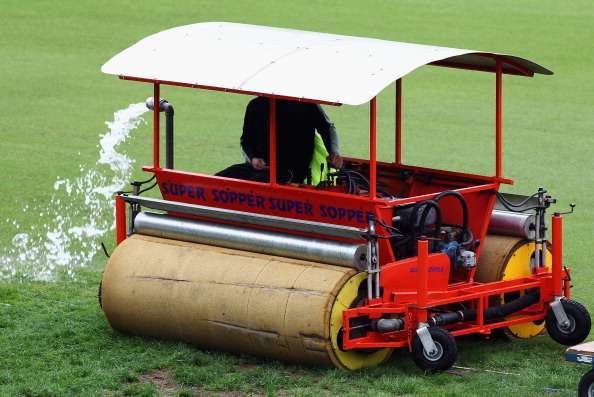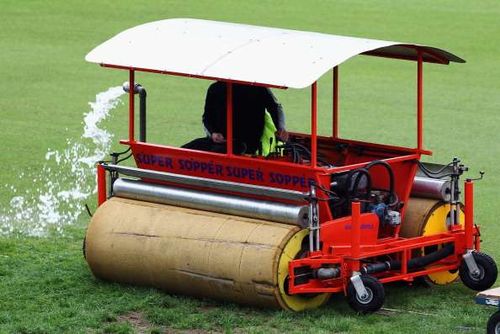
Super sopper: The wonder weapon in the man versus rain battle
During India's recent tour of the West Indies, Virat Kohli's men needed to beat the hosts in the fourth test at Port of Spain to retain their number one ranking. With the West Indies at 2-48, things were panning out per plan. And just as the Indian skipper was orchestrating his troops to make inroads, he was to be denied.
As thousands back home vented their frustrations at their television sets, the weather gods of Trinidad were at their mischevious best.
"Inclement weather" and cricket don't blend very well. And should the blueprint for the ground not factor in the possibility of rain - as was evidently the case with the Queen's Park Oval at Port of Spain - chances are that human intervention to dry the ground are most likely to come up short.
That said, most international venues these days incorporate an even slope to aid faster draining of rainwater. While this and the mammoth covers, do the job arguably well, there's just one other vital weapon in the curator's arsenal that makes a monumental difference - the super sopper.
An accidental invention
The year was 1974 and 56 year old Gordon Withnall landed his golf ball in a water puddle at the Liverpool Golf Course in Sydney. The incident triggered the inventor in him and Withnall conjured up a quick fix solution in three days. He subsequently procured a patent for it and the super sopper was voted the best invention in the 1974 ABCTV program called 'The Inventors'.
Soon enough, local schools, tennis and cricket clubs across the country were placing orders. The Melbourne Cricket Ground (MCG) picked up one as well. And when the curator of The Oval in London witnessed a demonstration, he wasted no time in ordering one.
Little did Withnall know back in 1974 that his seemingly innocuous invention would years later revolutionise the manner in which moisture would be reamoved from outdoor playgrounds across the globe.
As I watched the action at the Karbonn Karnataka Premier League 2016 unfold in Hubballi, Karnataka, the heavens opened up. While the players headed to the comfort of the dressing room, the ground-staff headed out with covers in tow.
A steady shower ensued and the teams now wore a grim look on their faces with the prospect of squandering points looming large. But the ground staff weren't to be done in just yet. Just as soon as the rain subsided, out strolled the game changer - the super sopper.
Two of those magical creations of Gordon Withnall strolled the length and breath of the ground and in 15 minutes times, the players were out - this time with a grin, knowing all too well that there was a game to be won.
The water-guzzler
Watching the super sopper up close is fascinating. It works like the good old magician's trick - now you see it, now you don't. The reference here – of course – is to the water puddle, which fails miserably to combat the all-absorbing power of the super sopper.
Just how does the super sopper work it's magic? I walked across the ground and met up with the man in charge of the super sopper at the Karnataka State Cricket Association (KSCA) Stadium at Hubballi.
"It has a capacity of 150 litres," Chinnaguriah tells me. "The sponge soaks up the water and the hydraulic pump getessions out the water." A no brainer you'd think, but I remind myself that it's the simple marvels of life that are the most effective.
"It runs on a 6 hp petrol engine and maintenance is easy," he says. "We just need to check the hydraulic oil, change the engine oil on a monthly basis, clean the air filters and the spark plug regularly."
Chinnaguriah, pleased with all the attention, divulges more. "For an hour's worth of usage, it drinks up 5 litres of petrol," he says. An observer could easily mistake the conversation for an enquiry over a brand new two-wheeler that I might intend to purchase.
And just as you would investigate the tyres of an automobile, the sponge which forms the outer layer of the roller drew my attention.
"The sponge is of 32 density calibre," he says while adding that it tends to last quite long owing to the good outfield at Hubballi.
And despite running the risk of sounding stupid, I couldn't resist the temptation of asking if one needs a license to drive it. "No, no", he chuckled, as his did colleagues who had by now gathered around to eavesdrop on this impromptu interview. "They just train us how to use it and thereafter, we start working with it".
Needless to say, it does help if one knows a thing or two about engines and automobiles. It's an added skill that enables a candidate to land the job of driving the super sopper at a cricket ground.
"I am also a mechanic," Chinnaguriah says. "I am responsible for the super sopper and grass-cutting machines," he added with a visible sense of pride.
I learn thereafter that the KSCA imports its super sopper's from Australia at approximately Rs.45 lacs a unit. Certainly expensive, but considering the pressure that cricket associations face to put up uninterrupted games, it's money well spent.
And just as we finish our conversation, a drizzle picks up again. But Chinnaguriah is unperturbed. He mounts his wonder-machine and is ready to take it out for a spin.
For, in the battle of man versus the water puddle, it's the former that usually wins, thanks to Gordon Withnall's ingenious creation - the super sopper.
Also read: India vs New Zealand 2016: Sick Kane Williamson fails to train ahead of the second test
